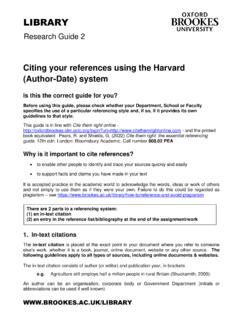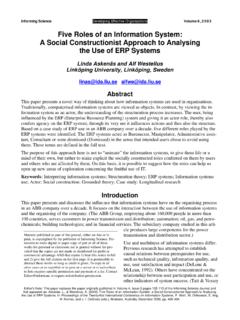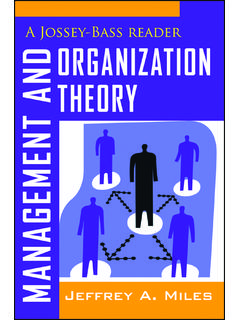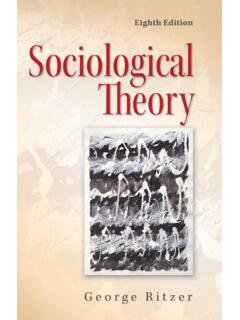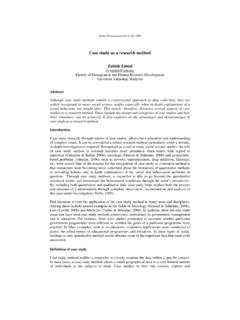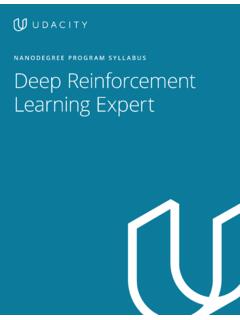Transcription of STAKEHOLDER THEORY CLASSIFICATION, DEFINITIONS AND ...
1 1 STAKEHOLDER THEORY CLASSIFICATION, DEFINITIONS AND ESSENTIAL CONTESTABILITY Dr. Samantha Miles Reader in Accounting and Finance, Research Lead Accounting, Finance and Economics Faculty of Business, Oxford Brookes University, Headington Campus, Oxford, OX3 0BP, UK, 2 STAKEHOLDER THEORY CLASSIFICATION, DEFINITIONS AND ESSENTIAL CONTESTABILITY ABSTRACT Purpose Recognising the STAKEHOLDER concept as an essentially contested concept subject to multiple competing interpretations, this chapter presents a systematic meta- THEORY level conceptual analysis of STAKEHOLDER THEORY . A conceptual enquiry is required for optimal development of STAKEHOLDER THEORY : to reduce conceptual confusion and prevent STAKEHOLDER THEORY from developing into an accumulation of disparate ideas. Methodology A bounded systematic review was undertaken to extract the extant range of STAKEHOLDER DEFINITIONS .
2 Using a meta-level conceptual enquiry the DEFINITIONS were deconstructed and analysed to establish how these relate to variants of STAKEHOLDER THEORY . Determinants of the STAKEHOLDER concept were reconstructed, sorted, filtered and ordered to produce a comprehensive, multidimensional classification of STAKEHOLDER THEORY which was then subjected to empirical testing. Findings 593 different STAKEHOLDER interpretations were identified, analysed, sorted and ordered into a classification model based on 4 hyponyms leading to 16 definitional categories. The classification was tested with positive results. Limitations The conceptual enquiry focuses exclusively on management literature: Alternative worldviews may propose alternative variables/classifications. Originality STAKEHOLDER THEORY has been accused of being an umbrella concept rather than a distinct THEORY per se. The proposed classification, based on an unparalleled systematic review and meta-level analysis of STAKEHOLDER DEFINITIONS , clearly indicates that STAKEHOLDER THEORY is a single THEORY .
3 Through the analysis of multi-contextual contributions to 3 STAKEHOLDER THEORY , an invaluable overview of what we know about STAKEHOLDER THEORY is presented in one model, illustrating how contributions are aligned and interrelated and thereby prescribing what is acceptable (unacceptable) as inclusion within STAKEHOLDER THEORY . KEYWORDS: Conceptual enquiry, Essentially contested concept, Meta- THEORY , STAKEHOLDER DEFINITIONS , STAKEHOLDER classification. 4 Central to STAKEHOLDER THEORY is the concept of the STAKEHOLDER , but what is a STAKEHOLDER ? This appears a simple question but is not one that has been answered with any degree of consensus. The lack of consensus arises from the very nature of STAKEHOLDER THEORY , as an amalgamation of eclectic narratives (Gilbert and Rasche, 2008) spanning strategic management, business ethics, marketing, human resource management, finance and corporate governance as well as far reaching adoption outside of business disciplines.
4 Widely different conceptualisations of STAKEHOLDER THEORY and STAKEHOLDER DEFINITIONS have emerged from these narratives as different DEFINITIONS and approaches are generated to serve different purposes (Freeman, Harrison, Wicks, Parmar, and DeColle, 2010), each focusing on attributes that are relevant to context. As a consequence hundreds of STAKEHOLDER DEFINITIONS exist (Miles, 2011). Such profusion is testimony to the appeal of STAKEHOLDER THEORY but it is also one of its prominent theoretical liabilities (Phillips, Freeman and Wicks, 2003:479) and an issue that opponents, such as Sternberg (1997) are quick to criticize. There have been numerous calls made by academics ( Freeman et al., 2010; Friedman and Miles, 2006; Kaler, 2003; Miles, 2012, 2015; Starik, 1995) seeking further clarification of the definition in order to advance STAKEHOLDER THEORY , as It is by defining what is and what is not a STAKEHOLDER that we create the reality of whose interests are, and are not, attended to and, in turn, discriminate what is, and is not, empirically tested by academics, attended to by managers or, regulated in practice.
5 (Miles, 2015:2). Friedman and Miles (2006) presented an early effort to sort, filter and structure this complex field of enquiry. At that time we saw STAKEHOLDER THEORY as reaching a crossroads, fuelled by enormous growth in popularity and uptake among academics, 5 practitioners and policy makers but hampered by widespread misappropriation of the STAKEHOLDER concept that threatened its survival as a useful business concept. We reviewed 75 texts to determine the boundaries of what constitutes a STAKEHOLDER . This review, although somewhat hurried and unstructured, returned 55 different STAKEHOLDER DEFINITIONS raising the question of how profuse, and confused the concept had become. At the time this represented the most comprehensive overview of the STAKEHOLDER concept. In 2008 I embarked on a major review of the STAKEHOLDER concept to address this problem in a more systematic and comprehensive manner.
6 This became a much larger, more time consuming project than I first envisaged, returning a seemingly impenetrable 1892 articles to review from the research protocol To establish the range of STAKEHOLDER DEFINITIONS using a review of works which have STAKEHOLDER (s) in the title, published in high quality academic management journals, up to and including 2008 . This created a database of 563 DEFINITIONS , of which 435 were discrete instantiations. The initial findings from the analysis formed the basis of my paper presented at the EIASM 1st interdisciplinary conference on stakeholders, resources and value creation (Miles, 2011). At the same conference I also presented the preliminary findings of a paper on the STAKEHOLDER concept as an essentially contested concept (ECC) according to the philosophy of Gallie (1956), which was subsequently published (see Miles, 2012).
7 ECCs are not just ambiguous or radically confused concepts subject to substantial semantic arguments, but those in which the arguments involve substantive perpetual political arguments. Recognition of the STAKEHOLDER concept as an ECC has important consequences for THEORY development and I will return to this point later. The database was updated in 2012 evidencing 593 different interpretations from 885 DEFINITIONS . 6 Does it matter if there are hundreds of instantiations? If Mitchell, Agle, and Wood (1997) had access to the entire population of STAKEHOLDER DEFINITIONS would they have concluded that power, legitimacy and urgency are the only necessary attributes for STAKEHOLDER recognition? Are the potentials for threat or co-operation (Savage, Nix, Whitehead and Blair, 1991) the only considerations necessary for STAKEHOLDER strategy formulation?
8 Likewise are the centrality of the focal organization and the density of the STAKEHOLDER network sufficient considerations for assessing STAKEHOLDER influencing strategies (Rowley, 1997)? This logic applies to all STAKEHOLDER models: the more informed we are about what constitutes a STAKEHOLDER the more robust ensuing STAKEHOLDER theories will be and the potential for misinterpretation and distortion (Phillips et al., 2003) will be reduced. What is needed is a meta- THEORY for STAKEHOLDER THEORY . Such a meta- THEORY should consider the nature and limits of, and relationship between, STAKEHOLDER determinants so that resulting theories and practices are theoretically sound and internally consistent. This requires a conceptual exploration, or philosophical discussion, of the foundations and structure of STAKEHOLDER THEORY .
9 There is a risk that, in the absence of a meta- THEORY , the increased complexity associated with multi-contextual applications increases the likelihood of misinterpreting, misunderstanding and misappropriating the STAKEHOLDER concept and STAKEHOLDER THEORY in general. A meta- THEORY prescribes what is acceptable (and unacceptable) as a THEORY . It would underpin STAKEHOLDER THEORY by enabling an assessment of how STAKEHOLDER THEORY has developed and how it should develop in future. The starting point for any meta- THEORY is a conceptual enquiry into the underpinning concepts and principles. 7 This chapter proposes the beginnings of a meta- THEORY for STAKEHOLDER THEORY by bringing together my previous research (Miles, 2011, 2012, 2015) to present a conceptual enquiry into the central STAKEHOLDER concept.
10 Collectively this conceptual enquiry distinguishes between multi-contextual narratives, identifies sorts and orders the essential attributes required for STAKEHOLDER status, considers the implications of the STAKEHOLDER concept as an ECC and culminates in the first systematic, multi-dimensional classification of STAKEHOLDER THEORY and DEFINITIONS , tested with positive effect. The chapter concludes with a discussion of implications for future STAKEHOLDER THEORY research. What is a STAKEHOLDER ? Freeman (1984) defined a STAKEHOLDER as any group or individual who can affect, or is affected by, the achievement of a corporation s ( ) or organization purpose ( ), firm s objectives ( ), organization s objectives ( ) or performance ( ). Whilst variants of these five subtly different DEFINITIONS from his seminal text remains the most sited the collective view derived from management literature is far more complex.
